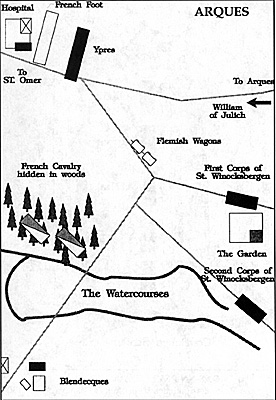The war against the French did not end with Courtrai, and after the first flush of victory the Flemings became bolder in their strategic aims and operational methods. In 1303 the Flemish leader William of Julich attempted to take the border town of St. Omer from the French. He took up a position nearby at Arques. On Maundy Thursday, 4 April, the Flemings advanced in five widely separated, yet still mutually supporting, divisions. The first division from Ypres stormed Arques and annihilated a small French garrison.
The French commander at St. Omer, Jacques de Bayonne, summoned his heavy cavalry and infantry and advanced on the Flemings. The French were at first panic-stricken, some fled, and all would not move till they had confessed and received absolution. After Courtrai, the French had a healthy respect for the Flemings. Not only did the uncivil burghers murder prisoners, but they killed horses too! Several sources mention how the French did not like fighting the Flemings because they lost a lot of horses. Since a good warhorse was a considerable investment this economic factor quite heavily upon them.
Eventually the French commander at St. Omer, Jacques de Bayonne, was able to get his men out of the city. He had about 1,300 heavy cavalry, accompanied by a small band of foot soldiers. Debouching from St. Omer, they saw the leading division of the Men of Ypres, and detached most of their infantry to face them at a hospital just outside the walls. The Leliaerts amongst the French seem to have known of the Flemings plans. and dutifully informed their French masters.
The French then took the rest of their infantry, and all their cavalry, and swung to the south, towards Blendecques, then turned north, crossed some watercourses and made to fall on the flank of the Ypres contingent, or perhaps catch another group of Flemings undeployed on the march. The French hid in a woods and waited. While there, they spotted a detachment escorting the Flemish baggage. The French sent the remainder of their infantry to attack and capture this lightly defended group. This division of the French (mostly infantry) took the baggage, and then began retreating towards St. Omer, taking no further part in the fighting. The remaining French forces, about 1,600, mostly knights, attacked another of the Flemish divisions, one from St. Winoksbergen, charging out of the woods. They sought to gain surprise by this but the Flemings quickly formed up and stood their ground although attacked in front, flank, and rear. Another detachment from St. Winoksbergen, came to their aid, but were attacked before they could form and were ridden down by the French. The survivors however reformed in a garden and beat off their assailants.
At this point the Flemings were in trouble, but William of Julich came up with the last two detachments and, putting them in good order, advanced on the French. William had commanded all his nobles to fight on foot with the communal troops. He neglected to send away his own horse soon enough, however, and it was captured. The French made to attack the Flemings several times, but did not even come to hand-to-hand combat with the stolid ranks of pikes and goedendags. They tried to lure the Flemings out of the formation to be pounced upon singly, or to find a weak spot in the hedgehog.
The Flemings were not to be so tricked, and the French began to retreat. William however was not going to let them off easily and he advanced, forcing the French to deploy again and again. This went on for some time and the French retreat was delayed. This delay had allowed the first division, the Men from Ypres, time to block the direct retreat to St. Omer. The French forces then broke up and fled by a circuitous route. William pursued up to St. Omer, overtook the French who had plundered his baggage, and put them to flight, recapturing the booty.
While the French were not destroyed, the battle of Arques is another example of how widely separated infantry forces, moving over more or less open country, could act in a coordinated manner, and stand against cavalry attacks. Of the two Flemish divisions that were defeated, one was mostly non-combatant valets and wagoners, and the other simply would not stand. Yet even that later one reformed its survivors and held out till help arrived. Significantly the Flemings were able to handle themselves in such an open battle without the benefit of terrain, though it must be admitted they had a large numerical advantage.

More Flanders
-
Flanders Introduction
Flanders Revolt
Battle of Courtrai: July 11, 1302
Battle of Arques: April 4, 1303
Battle of Mons-En-Pevele: August 18, 1304
Orders of Battle
The Flemish Style of War and Bibliography
Back to Table of Contents -- Courier #74
To Courier List of Issues
To MagWeb Master Magazine List
© Copyright 1998 by The Courier Publishing Company.
This article appears in MagWeb (Magazine Web) on the Internet World Wide Web.
Other military history articles and gaming articles are available at http://www.magweb.com